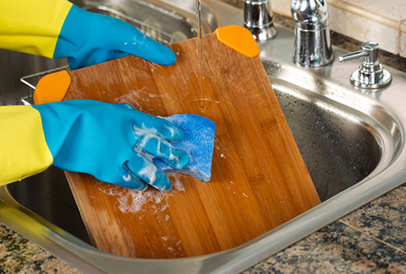(This article by Barb Fuller and Laura Sternweis was published Sept. 4, 2014, by Iowa State University Extension and Outreach and is reposted here with permission.) September is National Food Safety Education Month and an appropriate way to celebrate is to clean the kitchen, says an Iowa State University Extension and Outreach specialist.
“The kitchen can become a breeding ground for dangerous bacteria. Cleaning your kitchen before you prepare and enjoy foods can protect you and your family from food poisoning,” said Barb Fuller, a human sciences specialist in nutrition and health.
 Fuller shared these tips from the Academy of Nutrition and Dietetics.
Fuller shared these tips from the Academy of Nutrition and Dietetics.
- Wash your hands often — front and back, between fingers, under fingernails — in warm, soapy water for at least 20 seconds (or for two choruses of “Happy Birthday”) before and after every step in preparing or eating foods.
- Clean all work surfaces often to remove food particles and spills. Use hot, soapy water. Keep nonfood items – mail, newspapers, purses, reusable tote bags — off counters and away from food and utensils. Wash the counter carefully before and after food preparation, as well as items commonly touched such as cabinet knobs and the refrigerator handle.
- Wash dishes, cutting boards and cookware in the dishwasher or in hot, soapy water, and always rinse them well. Remember that chipped plates and china can collect bacteria.
- Replace old cutting boards that have cracks, crevices and excessive knife scars.
- Change towels and dishcloths often and wash them in the hot cycle of your washing machine. Allow them to dry out between each use. If they are damp, they’re the perfect breeding ground for bacteria. Throw out dirty sponges or wash them in a bleach-water solution.
- On any appliance, clean spills up right away. Wash appliances with hot, soapy water. Pay close attention to the refrigerator and the freezer shelves, sides and door where foods are stored.
- Spills and food splatters inside the microwave also can collect bacteria, so clean it regularly as well.
For more information about food safety from the Academy of Nutrition and Dietetics, visit www.HomeFoodSafety.org.
